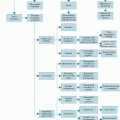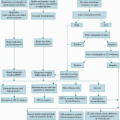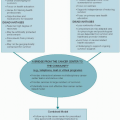Principles of Fistula and Stoma Management
Paula Erwin-Toth
Linda J. Stricker
Fistula formation in people with cancer is not an uncommon complication. Predisposing factors relate fistula formation to the type and extent of the malignancy, comorbid conditions, immunosuppression, and radiation-related damage to tissues and vessels (1,2,3).
Patients presenting with a variety of pelvic and abdominal cancers undergo fecal or urinary diversions as part of the surgical management plan. Procedures are performed with the intent of primary intervention for curative resection, extensive but resectable malignancy, or as palliation to relieve an obstruction (4,5). Other types of stomas seen in cancer management include esophagostomy, tracheostomy, and gastrostomy (5,6).
FISTULA MANAGEMENT
Patients presenting with a fistula face immeasurable physical, psychological, social, and financial challenges (1,2). Adding this burden to a poor prognosis is a terrible blow. The goals of management include identifying and treating sepsis, stabilizing fluid and electrolyte balance, nutritional support, quantification of effluent, containment of fistula output, protection of perifistular skin, odor containment, and patient comfort (1,2,9). Even in patients without a terminal disease, mortality rates associated with an enterocutaneous fistula (ECF) range from 5% to 15% (3,10).
Fistula management is rarely a straightforward process. For patients in palliative care, it is even less so (5). Optimizing the physiologic state may not be compatible with the palliative plan of care and the right to self-determination. Patients and families need to understand how decisions will affect the relative success of fistula management (8).
A fistula is an abnormal communication from one epithelial surface to another epithelial surface (1,2,11). This includes internal connections from one organ to another organ or from an organ to the surface of the skin (1,2,11). A fistula, following the path of least resistance, develops at the site of a previous drain or incision, at the site of active disease, proximal to a distal obstruction, or in association with an anastomotic leak, tissue ischemia, an infectious process, or an abscess (1,3,9,11,12).
Signs of an impending fistula include localized erythema and pain with increasing discomfort, leukocytosis (which may not be evident with immunosuppressed patients), fever, fluid and electrolyte imbalances, altered mental state, and general malaise. The specific name of the fistula is according to origin to exit points (1,2,8).
MEDICAL MANAGEMENT
Medical management for a patient with a fistula centers on controlling sepsis, stabilizing fluids and electrolytes, and optimizing nutritional status (1,2,3,9,12,13). Radiography will identify the origin of fistulae, and computerized tomography (CT) scan will aid in making the diagnosis (9). In some cases, interventional radiology will use CT-guided assistance to drain an abscess and place a catheter to facilitate resolution (9). Depending on the type and extent of the fistula, intravenous fluids, antibiotic therapy, and enteral or parenteral nutritional support are considered in the management plan. Conservative therapy may elicit spontaneous closure of a fistula but only under optimum conditions (1,2,14). Once epithelialization (also known as stomatization) of a fistula tract has occurred, it will not close without surgical intervention (1,9,15). The difficulty arises in determining the role, if any, these interventions play in palliative care (5,8).
Medical management of fistulae has the primary goal of spontaneous closure. Using conservative methods such as nutritional management, fluid and electrolyte balance, and containment provides options for care. In cases where fistulae output is high, using medications (see Table 28.1) such as H2 antagonists, somatostatin-14, or octreotide to decrease secretions combined with placing the patient NPO with nutritional support can create an environment for spontaneous closure (2,16). Prolonged bowel rest can result in atrophy of the intestinal villa, so use of this strategy is carefully monitored and should be time limited based on patient response (1,2,16).
TOPICAL MANAGEMENT
Topical management of fistulae is an applied science. Combining the fundamentals of wound and ostomy management in unique ways will achieve a plan of care to manage an individual situation. The goals of topical therapy in fistula care include containing effluent to quantify and control odor, facilitate comfort, assist in pain management, and restore and maintain integrity of the perifistular skin (1,2,3,7,8). Wound, ostomy, continence (WOC) nurses can
be a tremendous asset in developing a plan of care for the patient with a fistula (10,16,17,21).
be a tremendous asset in developing a plan of care for the patient with a fistula (10,16,17,21).
TABLE 28.1 Medications for decreasing secretions in fistulas when output is high | ||||||||
|---|---|---|---|---|---|---|---|---|
|
NEGATIVE PRESSURE WOUND THERAPY
Stay updated, free articles. Join our Telegram channel

Full access? Get Clinical Tree







